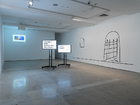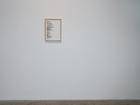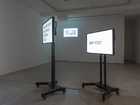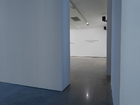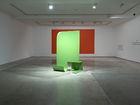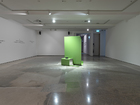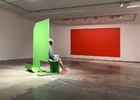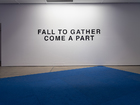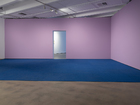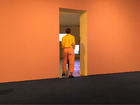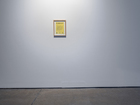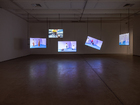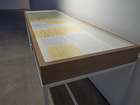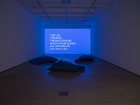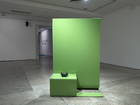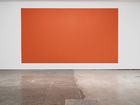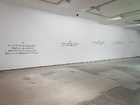EXHIBITION GUIDE
This four-gallery solo exhibition by Agatha Gothe-Snape and Wrong Solo features new and newly reimagined artworks spanning video, binaural sound, sculpture, poetry, performance, drawing, and installation. A series of psychic spaces provide an apparatus for processing fragmentary encounters, movements, feelings, and states of consciousness. Ordinary situations and chance-based chains of events are methodically worked through, allowing meaning—however tenuous—to be extracted from the layers of disguise found in dreams, language, and other symbolic conventions. What might otherwise be viewed as inadvertent becomes significant. This sense of equivalency is not just a strategy for flattening or reordering established hierarchies, but for understanding and examining lesser known situations, objects, people, places, and histories. The archive, including the institution or studio-as-archive, is used to trace and register the complex web of actors that govern the relationships between things. However, the singular authority of the archive is often troubled: the practice of self-archiving allows for idiosyncratic hierarchies of information; what or who is recalled is only as important as what is left out; and recollections frequently give way to false memories, dreams, or fictions. Perhaps, then, it is the process or act of remembering that is more important. The spaces of art—from the desk to the studio, the rehearsal space, and the gallery—are organised as mnemonic devices; memory palaces that open the interior space of the psyche out into public view. The parameters of physical spaces make for fluid associations: an opening is an entry is an exit. And the external world gives cues to enter an internal one: to close the eyes, to listen, to observe one’s own position.
Curated by Madeleine King.
GALLERY 1
Dream states are invoked by references to Odilon Redon’s symbolist painting Woman sleeping under a Tree, 1900- 1901—whose colour palette of mauves, oranges, and blues recur throughout the exhibition—Sonia Delaunay’s 1913 illustration for Blaise Cendrars’s poem Trans-Siberian Express, and August Strindberg’s seminal modernist work, A Dream Play, 1902. Redon's painting is the subject of a video work presented at the scale of the original, produced using Gothe-Snape’s idiosyncratic animation tool, Microsoft Powerpoint. As though only faintly recalled, Redon’s painting is blurred such that its female subject is no longer visible, but its suggestion of a celestial connection somehow remains. Strindberg’s cues and sketches for the set design of A Dream Play form the basis of a new wall drawing that sits adjacent. The dream at the centre of the play marks a return passage from heaven to earth for the female protagonist, Agnes—the daughter of deity Indra. In the play, as in a dream, the function of the sets, props, and characters become conveniently substituted or reassigned scene to scene. The playwright’s description of a gate at the entrance of a passageway has a poetic resonance with Gothe-Snape, whose own work Three physical doorways, one conceptual wedge and a gentle breeze dwells on the anticipation of an open door. In A Dream Play the meaning of a door opening is debated by the deans of theology, philosophy, law, and medicine, who tangle with its potential for danger, knowledge, and truth; a gate ajar may represent freedom or imprisonment, paradise or hell, depending on the orientation of the passage.
Powerpoint presentations, a parochial visual communication tool of the corporate world, in Gothe-Snape’s hands becomes a surprisingly poetic, humane, and intimate medium. A new video work produced in this format—using fragments of found, overheard, and original prose—is played back across two monitors that have fallen out of synch with each other. By chance, the repetition of the same phrases at different intervals play out like a Socratic dialogue interrogating two sides of a moral dilemma with some degree of rigour and insight.
Also presented is a redacted-poem-as-drawing, titled She’s Asleep. It uses an excerpt from the 1913 book produced by avant-gardes Blaise Cendrars and Sonia Delaunay, La prose du Transsibérien et de la Petite Jehanne de France (Prose of the Trans-Siberian and of Little Jehanne of France); the first book made using the principles of Simultaneity—a cubist style coined by Delaunay and her husband Robert Delaunay in which contrasting colours are used to produce vibrating movement and rhythm. Gothe-Snape encountered this work at the same time as the Redon painting.
GALLERY 2
Woman sleeping under a Tree makes a subtle reappearance in the second gallery space through The Five Unknowables. Originally presented in 2018 as a text piece for windows, Gothe-Snape’s work is here expanded as a combination of wall text, sculpture, and in-situ performance captured in the form of binaural recording; a new iteration of the text is now a play.
The sculpture is a single sheet of steel folded, cut, and bent into a vessel for the body, creating a work that is at once monumental and intimate, born directly from the situation of the encounter. Painted Pea Green, and alluding to Chroma Key Green, it threatens its own erasure in post-production. This vulnerability, or fleeting sense, is also at play in the performance.
The sound work, or trace of this performance—created in collaboration with composer and sound artist Alex White and performed by Brian Fuata and Gothe-Snape—uses binaural recording techniques, where the sound is recorded from the perspective of the human ear canal to create an immersive audio experience when heard through headphones. The live performance in the gallery space (view at ima.org. au/exhibitions/agatha-gothe-snape-certain-situations/), accompanied by an improvised composition for modular synthesiser and grand piano, is captured from the perspective of a listener seated on the sculpture. A psychoacoustic illusion is formed and overlayed across the gallery space. This work continues Gothe-Snape’s interest in the relationship between performance and its documentation, and how the gallery, like the human ear, can be both a receptable and playback device, summoning past situations.
GALLERY 3
The largest gallery space is dedicated to a new work by Wrong Solo, Gothe-Snape’s long-running collaboration with artist Brian Fuata. Titled Five Columns, the work is a five-channel video installation entered via a mauve-walled, blue-carpeted antechamber; a reproduction of Wrong Solo’s studio in Sydney. Beyond the antechamber are a series of screens presenting fragments of performed durational improvisations that are as earnest as they are absurd.
To create the work Gothe-Snape and Fuata invited a supportive network of five interlocutors— Sonya Holowell, Ruark Lewis, Sarah Rodigari, Brooke Stamp, and Lizzie Thomson—to co-create a situation. Performances were filmed over five consecutive days, sharply between 4pm and 4.10pm; all but one at Wrong Solo’s studio. Consciously situated beyond the antechamber —‘the curtain’ and ‘the stage’—the five performers attempt to make sense of the spaces that they inhabit, as well as recall instructions and various forms of knowledge. A situation is in motion.
Five Columns underlines the relationship between performance and its documentation. The performances have been filmed in a cinéma-vérité style, and presented with minimal editing; the videographer is often seen passing in front of the second camera, and the edges of the film ‘set’ are occasionally made visible. A vitrine and framed letter give a museum treatment to the ephemera generated in the planning of the performances, and the reproduction of the studio space that the performances took place in draws on a now familiar trope of artist-studio-as-artefact. The overall effect is one of an instant-archive, whereby the very first presentation of the work declares its own preservation.
GALLERY 4
This last space makes connections back to the first, providing an epilogue of sorts. References to Strindberg's A Dream Play, Redon's Woman spleeping under a Tree, and fragments of prose presented Gothe-Snape's own Interior Dialogue for Powerpoint recur here and find substituted form. The final work, a very subtle spatial intervention, holds the door to this inner chamber slightly ajar.





